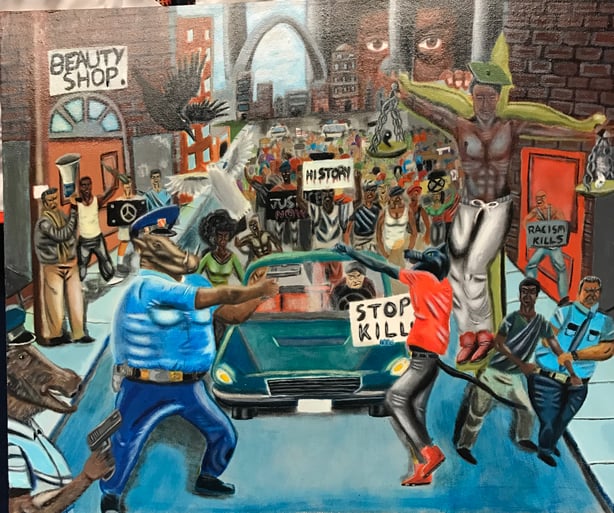A controversial painting removed from display at the U.S. Capitol will not be returning to display after the U.S. District Court denied a request for an injunction before the exhibition in question came to an end. While the court acknowledged that St. Louis teenager David Pulphus’s Untitled #1 had been removed based on its viewpoint, it ultimately held that Pulphus was not the one “speaking,” the government was. As such, it was free to do as it wished. The court’s opinion carefully considered the factors that determine whether the speaker is the government or a private citizen, but as it acknowledged, the line can be hard to draw. The opinion has implicationsfor other cases where art in public spaces stirs controversy.
As we reported a few months ago, the case has been a colorful one. The painting, Untitled #1, shows a confrontation in downtown St. Louis between protestors, who are largely African American, and police, who are depicted as pigs. Among the more over connotations was the context of the clashes in Ferguson, Missouri following the death of Michael Brown in 2014. It was chosen last year as the winner of an initiative by then-Speaker of the House, Thomas P. (“Tip”) O’Neill, Jr. in 1982. The initiative encourages individual Representatives to hold competitions in their own districts, and then display the winners in the tunnels connecting the Capitol to the House office buildings. The artist, student David Pulphus, was the winner in the district of William Lacy Clay (D-MO).

Untitled # 1 (Image courtesy of David Pulphus)
Starting in early January, 2017, however, the painting was repeatedly removed and returned to the office of Rep. Clay who, in turn, re-hung the painting each time. Duncan Hunter (R-CA) personally removed the painting, and Dave Reichert (R-WA) referred to the work as “insulting to police officers.” Seeking resolution, Rep. Reichert wrote to the Architect of the Capitol to request the permanent removal of the work as in violation of House rules concerning “subjects of contemporary political controversy or a sensationalistic or gruesome nature.” The painting was taken down, and Pulphus and Rep. Clay sued. They asked for an injunction to compel that the painting be returned to display.
To obtain an injunction, a plaintiff must show three things: (1) he is likely to prevail on his case eventually; (2) without an injunction he will suffer irreparable harm (not a loss of money, but something that cannot be fixed later); and (3) all things considered, the balance of equities favor him. Here, the court found that Pulphus and Clay would not prevail on their claims, so the other two factors did not come into play.
The court was sympathetic to Pulphus’s point that the painting had been removed because of what it depicted, but as noted above, one only has First Amendment rights when one is the speaker. When the government speaks, private citizens have no individual right about what the government does, or does not say. Thus, this case turned entirely over whether Pulphus’s speech had been stifled by discriminating against his viewpoint in a forum the government had mad available (which would violate his First Amendment rights), or the government had spoken (which would cause Pulphus no cognizable injury). As the court said,
this case hinges on whether the art competition is a limited/non-public forum, or whether the art competition instead constitutes government speech. Plaintiffs contend that the government engaged in viewpoint discrimination when it removed Pulphus’s painting from display, which, if the competition is a limited or non-public forum, would likely violate plaintiffs’ First Amendment rights. But if the art competition is government speech, then plaintiffs have no First Amendment rights at stake and forum analysis does not apply; therefore, it does not matter if the government engaged in viewpoint discrimination.
The test to determine whether the government is the speaker is recognized to be (1) whether the medium at issue has historically been used to communicate messages from the government; (2) whether the public reasonably interprets the government to be the speaker; and (3) whether the government maintains editorial control over the speech.
The court reviewed these factors and concluded in sum that by virtue of its regulations the Architect maintained editorial control over the content. While individual representatives brought paintings from their districts, there was in effect a veto at the final stage. Although determining whether holding art exhibitions was historically “used to communicate messages from the government” was inconclusive, the court held that the public would reasonably interpret the government to be the speaker: “Art displayed on public property is often treated as being endorsed by the government or representative of the government’s views, and is therefore considered government speech.” And further (emphasis in the original):
While plaintiffs may be correct that viewers would not necessarily associate the “message” of any particular student’s artwork with the government, it nonetheless seems likely that viewers would assume that art hung on the walls of the Capitol, associated with a congressional district, and labeled with the name of a member of Congress, was in fact selected by the government for display.
Lastly, given the rules of the program, the court was satisfied that the government retained editorial control through its final approval authority (to which entrants had to agree on a form).
Clearly the analysis turned on the details of the Capitol program, but it certainly has implications for other art display programs. With some regularity, there are outcries to remove controversial works of art from public display. If such displays are only permitted by requiring acknowledgement of editorial control like this program, then artists would never get to the forum analysis stage (which they would almost certainly win).



